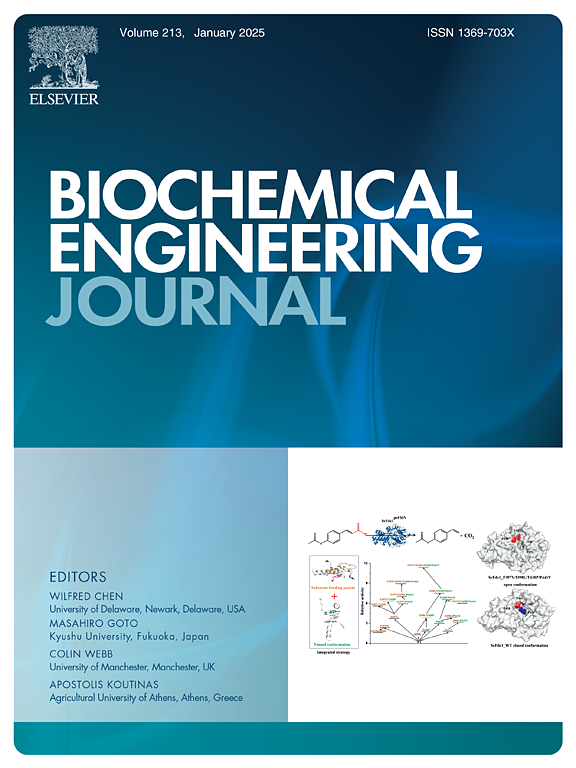Molecular modification and application of the key enzyme CYP109E1-H in 25-hydroxyvitamin D3 biosynthesis
IF 3.7
3区 生物学
Q2 BIOTECHNOLOGY & APPLIED MICROBIOLOGY
引用次数: 0
Abstract
25-Hydroxyvitamin D3 (25-OH-VD3) is one of the primary active forms of vitamin D3 (VD3) in the human body and has significant medicinal value. The traditional organic synthesis method of 25-OH-VD3 is very complex and the yield is very low. Biocatalysis can simplify the synthesis steps, with relatively mild reaction conditions and easy access to raw materials. Therefore, the production of 25-OH-VD3 through microorganisms has been considered a promising alternative to chemical synthesis. However, the recombinant expression system demonstrated poor catalytic activity and low substrate conversion efficiency, hindering the further application of 25-OH-VD3 biological synthesis. The purpose of this study is to improve the efficiency of biotransformation and increase the production of 25-OH-VD3 by modifying VD3 hydroxylase. Initially, the positive mutant CYP109E1I85F-H was obtained through saturation mutation. The concentration of 25-OH-VD3 was increased to 1.57 mg/L, which was 1.9 times that of the wild-type (WT) strain. Then, the electron transfer engineered strain WB600-pMA5-CYP109E1I85F-H-Fdx-FdR was constructed to further improve the efficiency of electron transfer, with a 14.5 % increase in product concentration. Finally, 14.53 mg/L of 25-OH-VD3 was achieved in optimized SR medium supplemented with dimethyl sulfoxide (DMSO) as co-solvent. The combination of semi-rational molecular modification strategy and optimization of the catalytic system increased the production of 25-OH-VD3 by 16.9 times compared with the WT strain, providing guidance for CYP109E1-H microbial synthesis of 25-OH-VD3.
25-羟基维生素D3生物合成关键酶CYP109E1-H的分子修饰及应用
25-羟基维生素D3 (25-OH-VD3)是人体内维生素D3 (VD3)的主要活性形式之一,具有重要的药用价值。传统的有机合成25-OH-VD3的方法非常复杂,收率很低。生物催化可以简化合成步骤,反应条件相对温和,原料容易获得。因此,通过微生物生产25-OH-VD3被认为是化学合成的一个有前途的替代方法。然而,重组表达体系催化活性差,底物转化效率低,阻碍了25-OH-VD3生物合成的进一步应用。本研究的目的是通过修饰VD3羟化酶来提高生物转化效率,增加25-OH-VD3的产量。最初,通过饱和突变获得阳性突变体CYP109E1I85F-H。25-OH-VD3浓度为1.57 mg/L,是野生型(WT)的1.9倍。然后构建电子转移工程菌株WB600-pMA5-CYP109E1I85F-H-Fdx-FdR,进一步提高了电子转移效率,产物浓度提高了14.5 %。最终,在优化后的SR培养基中,以二甲基亚砜(DMSO)为助溶剂,25-OH-VD3的浓度为14.53 mg/L。半合理分子修饰策略与催化体系优化相结合,使菌株25-OH-VD3产量较WT菌株提高16.9倍,为CYP109E1-H微生物合成25-OH-VD3提供指导。
本文章由计算机程序翻译,如有差异,请以英文原文为准。
求助全文
约1分钟内获得全文
求助全文
来源期刊

Biochemical Engineering Journal
工程技术-工程:化工
CiteScore
7.10
自引率
5.10%
发文量
380
审稿时长
34 days
期刊介绍:
The Biochemical Engineering Journal aims to promote progress in the crucial chemical engineering aspects of the development of biological processes associated with everything from raw materials preparation to product recovery relevant to industries as diverse as medical/healthcare, industrial biotechnology, and environmental biotechnology.
The Journal welcomes full length original research papers, short communications, and review papers* in the following research fields:
Biocatalysis (enzyme or microbial) and biotransformations, including immobilized biocatalyst preparation and kinetics
Biosensors and Biodevices including biofabrication and novel fuel cell development
Bioseparations including scale-up and protein refolding/renaturation
Environmental Bioengineering including bioconversion, bioremediation, and microbial fuel cells
Bioreactor Systems including characterization, optimization and scale-up
Bioresources and Biorefinery Engineering including biomass conversion, biofuels, bioenergy, and optimization
Industrial Biotechnology including specialty chemicals, platform chemicals and neutraceuticals
Biomaterials and Tissue Engineering including bioartificial organs, cell encapsulation, and controlled release
Cell Culture Engineering (plant, animal or insect cells) including viral vectors, monoclonal antibodies, recombinant proteins, vaccines, and secondary metabolites
Cell Therapies and Stem Cells including pluripotent, mesenchymal and hematopoietic stem cells; immunotherapies; tissue-specific differentiation; and cryopreservation
Metabolic Engineering, Systems and Synthetic Biology including OMICS, bioinformatics, in silico biology, and metabolic flux analysis
Protein Engineering including enzyme engineering and directed evolution.
 求助内容:
求助内容: 应助结果提醒方式:
应助结果提醒方式:


